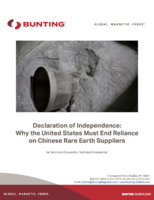EPSA President and CEO criticizes NUS survey comments.
Share:
Press Release Summary:
John E. Shelk, President and CEO of EPSA, criticized comments made by the NUS Consulting Group on June 4 in releasing their annual survey on electric rates paid by large customers served by major utilities. Survey highlights that rates are currently highest in several restructured states, such as California, Maryland, and New York. Shelk says there is not a clear correlation between rates, market design, and regulatory structure.
Original Press Release:
Consulting Group Survey Actually Shows Competition Does Not Cause Higher Electric Rates
"The comment in the firm's press release attempting to link rising rates to electric restructuring and competition is undercut by their own survey data."
WASHINGTON, D.C. - John E. Shelk, President and CEO of the Electric Power Supply Association, today criticized comments made by the NUS Consulting Group on June 4 in releasing their annual survey on electric rates paid by large customers served by major utilities. "The good news for large customers is that overall, rate increases in 2006 were half what they were in 2005 despite rising fuel costs and other expenses. However, the comment in the firm's press release attempting to link rising rates to electric restructuring and competition is undercut by their own survey data. If they were correct, there would be a clear correlation between rates and market design and regulatory structure, but there isn't," Shelk said.
According to a quote attributed to NUS Consulting Group co-President Richard Soultanian, "Retail deregulation is currently either stalled or ineffective in much of the country." Yet according to their own survey, the largest drops in rates occurred in California (Southern California Edison, 13.27%) and New Jersey (Public Service Electric & Gas, 11.46%), both restructured markets. Furthermore, rates in Georgia, Louisiana and Minnesota - all vertically-integrated regions - rose between 16 and 22 percent in the past year alone. Speaking on Monday to a conference of regional state regulators in Little Rock, Arkansas, Southern Company CEO David Ratcliffe predicted that rates will continue to rise in the Southeast due to higher demand and billions of dollars in expenses to address environmental compliance.
The NUS survey highlights that rates are currently highest in several restructured states, such as California, Maryland and New York. However, according to an article in the June 2007 Public Utilities Fortnightly written by members of the Brattle Group, "This discrepancy already existed in the mid-1990s, several years before restructuring was implemented." The article showed that rates are increasing everywhere, to the tune of 31 percent since 1997 regardless of market structure, including well over 50 percent in Washington, Wisconsin and Hawaii, all non-restructured states. "The facts prove that the link between rate increases and restructuring simply does not exist," said Shelk.
"A relevant characteristic that actually explains the differences in rates between regions is not whether they did or didn't restructure, but rather the historical differences in fuel mix," Shelk said. The Brattle Group report further underlines this point. Their independently conducted research found that the average cost of fuel in restructured states jumped approximately 90 percent from 1997-2005, while fuel costs increased only 62 percent in non-restructured states, a statistic completely independent from market design.
In conclusion, Shelk said, "It is long past time to stop blaming restructuring and competition for the challenges facing all of the nation's states and regional power systems. We should be working together on policies to achieve energy and environmental goals, not trying to place blame where it doesn't belong. As the nation seeks to meet future demand in a responsible manner, the discipline from competitive market forces is needed now more than ever."
CONTACT: JOHN SHELK
(202) 628-8200
EPSA is the national trade association representing competitive power suppliers, including generators and marketers. These suppliers, who account for nearly 40 percent of the installed generating capacity in the United States, provide reliable and competitively priced electricity from environmentally responsible facilities serving global power markets. EPSA seeks to bring the benefits of competition to all power customers.




